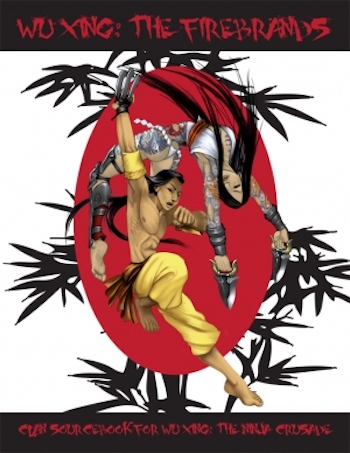 Last year Third Eye Games released Wu Xing. This was a ninja RPG with fantasy powers and which edged towards the dark and gritty rather than bright cinematic heroics.
Last year Third Eye Games released Wu Xing. This was a ninja RPG with fantasy powers and which edged towards the dark and gritty rather than bright cinematic heroics.
Wu Xing: The Firebrands is the first sourcebook in the series. It’s a clanbook.
The main rules detail a number of clans; the Bamboo Herbalists, the Blazing Dancers and Grasping Shadows to name but three. Wu Xing: The Firebrands is a clanbook that centres on the artists and performers of the Blazing Dancers and the tattoo covered Virtuous Body Gardeners.
It’s not an expensive sourcebook; coming in at about £6.00 or about $10.00 and delivering just over 90 pages. The writing team of Christopher Lee Simmons, Brennan Brishop and Eloy Lasanta create their world through the characters in it. Much of The Firebrands is presented as dialogue or the history of people. I actually rather enjoy discovering a world in this way but many gamers will dismiss this as fluff.
Whereas it’s true to say that plenty of the pages in this Wu Xing sourcebook are dedicated to information through flavour it would be wrong to write the supplement off as purely background. There’s plenty of crunch.
For example, we’re given four new sub-types within the clan; there’s the Tamers (animal trainers), Bellows (fire performers), The Thousand (mask wearing spy hunters) and The Hands (spies). There is a new passion (teaching), new dancer gifts (bellows, child of the Wu Ji theater, hands, Kakou born, Kokyuryu born, tamer, the thousand, warrior’s dance) and we can see that many of those echo back to the new sub-clans, new dancer drawbacks, new ink gifts, new ink drawbacks, new weapons, new fighting styles (fox style, scorpion style), new wushu (way of the fire, way of the inked skin) and even new celestial animals.
The Virtuous Body Gardeners make use of tattoos (hence the ink gifts) and as you’d hope from their clanbook this area is explored more fully. In addition to the new gifts and drawbacks we’re giving the origin of the tattoos and in keeping with the style Third Eye Games presents Wu Xing in this is a history rich in character, conflict and schism. It’s more than enough for any Wu Xing GM to draw inspiration from and weave plot strands out of.
Wu Xing shares a little more of the world too. The Wu Ji Theatre (the Infinite Theatre) is a central location for the Blazing Dancers and in The Firebrands we study it from creation to where it is today. I think Third Eye Games have thought carefully about the locations they’re adding. The city of Kokyuryu is interesting – monasteries built miles apart but close enough to be considered a single city by the administrators of the idea; ideal for tax purposes, also perfect for adverting. The city of Kokou is interesting – having run out of space to grow outwards it has grown upwards, up the side of the cliff.
You’ll notice both Kokyuryu and Kokou both mentioned among the new dancer gifts along with the Wu Ji. That fits in well with my watching of ninja and kingdom clashing Asian movie watching – where you come from seems to be as important in defining you as who you are.
Finally, Wu Xing: The Firebrands concludes with a pre-written adventure. I don’t tend to be a fan of these but the advance of this sort of inclusion is that this sourcebook can be a one stop solution for a GM in desperate need of injecting new and quick content into their Wu Xing game.
All in all; I enjoyed The Firebrands. I like the world that Third Eye Games are building and I like its feel.
Disclosure: This is not a play test review and my copy of the clanbook was provided for the purpose of reviewing.

